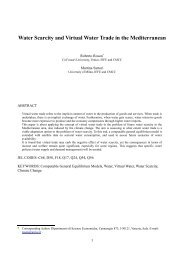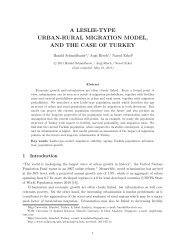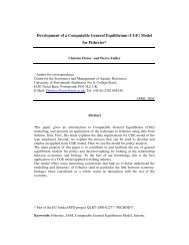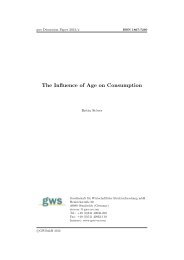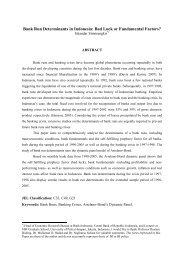Maturity Transformation and Interest Rate Risk in Large European ...
Maturity Transformation and Interest Rate Risk in Large European ...
Maturity Transformation and Interest Rate Risk in Large European ...
You also want an ePaper? Increase the reach of your titles
YUMPU automatically turns print PDFs into web optimized ePapers that Google loves.
Table 6: Percentage change <strong>in</strong> the value of an <strong>in</strong>dividual loan contract for various shock sizes, maturities<strong>and</strong> methods. Subtable (a) uses the Basel Committee guidel<strong>in</strong>e method, (b) uses the simplest flat yieldcurve loan pric<strong>in</strong>g model, (c) uses a model based on Nelson-Siegel forward rates calibrated to historicalparameters, <strong>and</strong> (d) uses Svensson forward rates also calibrated to historical parameter values. In eachsubtable the rows give the size of the shock, which is a parallel shift <strong>in</strong> the level of the forward curve,<strong>and</strong> the columns give the rema<strong>in</strong><strong>in</strong>g maturity of the loan contract.(a) Basel Committee guidel<strong>in</strong>e1 3 10 15 20 30-3.0% 2.1 6.8 19.9 26.8 33.6 39.0-2.0% 1.4 4.5 13.3 17.8 22.4 26.0-1.0% 0.7 2.2 6.6 8.9 11.2 13.0-0.5% 0.4 1.1 3.3 4.5 5.6 6.50.0% -0.0 -0.0 -0.0 -0.0 -0.0 -0.00.5% -0.4 -1.1 -3.3 -4.5 -5.6 -6.51.0% -0.7 -2.2 -6.6 -8.9 -11.2 -13.02.0% -1.4 -4.5 -13.3 -17.8 -22.4 -26.03.0% -2.1 -6.8 -19.9 -26.8 -33.6 -39.0(c) Nelson-Siegel (β 0 , β 1 , β 2 , τ 1 ) = (3.2, −.7, 4.5, 73)%1 3 10 15 20 30-3.0% 1.5 4.4 14.5 21.5 28.2 41.1-2.0% 1.0 3.0 9.6 14.1 18.5 26.7-1.0% 0.5 1.5 4.8 7.0 9.1 13.0-0.5% 0.2 0.7 2.4 3.5 4.5 6.40.0% 0.0 0.0 0.0 0.0 0.0 0.00.5% -0.2 -0.7 -2.3 -3.4 -4.4 -6.21.0% -0.5 -1.5 -4.7 -6.8 -8.8 -12.32.0% -1.0 -2.9 -9.3 -13.4 -17.2 -23.83.0% -1.5 -4.4 -13.8 -19.8 -25.3 -34.7(b) Flat rate δ = 3.2%1 3 10 15 20 30-3.0% 1.5 4.4 14.1 20.5 26.5 37.3-2.0% 1.0 2.9 9.3 13.5 17.4 24.1-1.0% 0.5 1.5 4.6 6.7 8.5 11.7-0.5% 0.2 0.7 2.3 3.3 4.2 5.80.0% 0.0 0.0 0.0 0.0 0.0 0.00.5% -0.2 -0.7 -2.3 -3.3 -4.1 -5.61.0% -0.5 -1.5 -4.5 -6.5 -8.2 -11.12.0% -1.0 -2.9 -9.0 -12.8 -16.1 -21.53.0% -1.5 -4.4 -13.4 -18.9 -23.7 -31.3(d) Svensson (β 0 , β 1 , β 2 , β 3 , τ 1 , τ 2 ) = (2.1, 1.1, 1.8, 5.5, 65, 855)%1 3 10 15 20 30-3.0% 1.5 4.6 18.7 29.2 38.0 49.9-2.0% 1.0 3.1 12.4 19.3 25.1 32.8-1.0% 0.5 1.5 6.2 9.6 12.4 16.1-0.5% 0.2 0.8 3.1 4.8 6.2 8.00.0% 0.0 0.0 0.0 0.0 0.0 0.00.5% -0.2 -0.8 -3.1 -4.7 -6.1 -7.91.0% -0.5 -1.5 -6.1 -9.4 -12.2 -15.62.0% -1.0 -3.1 -12.1 -18.7 -24.1 -30.83.0% -1.5 -4.6 -18.0 -27.9 -35.7 -45.44.2 How good is the Basel Committee <strong>in</strong>terest rate sensitivity guidel<strong>in</strong>efor loans?4.2.1 Effect of loan-specific pric<strong>in</strong>gThe Basel Committee guidel<strong>in</strong>es outl<strong>in</strong>ed <strong>in</strong> Section 1.1 do not take <strong>in</strong>to account the type of securityfor which an <strong>in</strong>terest rate risk assessment is be<strong>in</strong>g performed. In particular, the guidel<strong>in</strong>es may or maynot be suitable for typical loan contracts. We <strong>in</strong>vestigate the performance of the Basel Committeeguidel<strong>in</strong>e method for <strong>in</strong>terest rate revaluation sensitivity by compar<strong>in</strong>g it to our alternative simpleloan pric<strong>in</strong>g models of Section 3.2 with parametric forward curves specified <strong>in</strong> 3.3. The results aresummarised <strong>in</strong> Table 6. Under all methods, positive <strong>in</strong>terest rate shocks (<strong>in</strong>creases <strong>in</strong> the level of theforward curve) result <strong>in</strong> decreases <strong>in</strong> the value of a loan contract with any maturity, <strong>and</strong> decreases<strong>in</strong> <strong>in</strong>terest rates result <strong>in</strong> revaluation <strong>in</strong>creases. <strong>Large</strong>r absolute <strong>in</strong>terest rate shocks result <strong>in</strong> largeabsolute changes <strong>in</strong> value.The Basel Committee guidel<strong>in</strong>e method, like any duration-based sensitivity method 28 , producessensitivities that are symmetric about zero: positive <strong>and</strong> negative <strong>in</strong>terest rate shocks of equal absolutesize have an equal absolute revaluation effect; <strong>in</strong> other words, for any given loan maturity, thepercentage decrease <strong>in</strong> loan price from an <strong>in</strong>terest rate <strong>in</strong>crease is the same as the percentage <strong>in</strong>crease<strong>in</strong> loan price from an <strong>in</strong>terest rate decrease of equal absolute size. We can see that all the alternativesimple loan models, however, are able to capture the asymmetric revaluation effect of <strong>in</strong>terest ratechanges. At short maturities <strong>and</strong> for small shock sizes, these asymmetric effects are negligibly small,while at longer maturities <strong>and</strong> at larger shock sizes we note that loan prices are more sensitive todecreases <strong>in</strong> <strong>in</strong>terest rates. It is not surpris<strong>in</strong>g, therefore, that the Basel Committee guidel<strong>in</strong>e methodsometimes overstates, <strong>and</strong> at other times understates, the <strong>in</strong>terest rate sensitivity of loan prices.From the regulator’s po<strong>in</strong>t of view, we might be most concerned with situations where the Basel28 For an <strong>in</strong>troduction to duration-based sensitivity measurement, see Kaufman (1984).21




